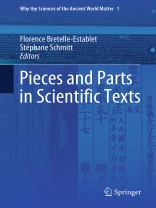This book starts from a first general observation: there are very diverse ways to frame and convey scientific knowledge in texts. It then analyzes texts on mathematics, astronomy, medicine and life sciences, produced in various parts of the globe and in different time periods, and examines the reasons behind the segmentation of texts and the consequences of such textual divisions. How can historians and philosophers of science approach this diversity, and what is at stake in dealing with it? The book addresses these questions, adopting a specific approach to do so.
In order to shed light on the diversity of organizational patterns and rhetorical strategies in scientific texts, and to question the rationale behind the choices made to present such texts in one particular way, it focuses on the issue of text segmentation, offering answers to questions such as: What was the meaning of segmenting texts into paragraphs, chapters, sections and clusters? Was segmentation used to delimit self-contained units, or to mark breaks in the physical appearance of a text in order to aid reading and memorizing, or to cope with the constraints of the material supports? How, in these different settings and in different texts, were pieces and parts made visible?
Tabella dei contenuti
Part I: Introductory Remarks.- Chapter 1. Introduction (Florence Bretelle-Establet and Stéphane Schmitt).- Chapter 2. Textual Places: “Parts of Text” and “Stretches of Text” (Julie Lefebvre).- Part II: Material Parts of Texts.- Chapter 3. Segmentation of Texts in Old Babylonian Mathematics (Christine Proust).- Chapter 4. Textual Segmentation in Babylonian Astral Science (Mathieu Ossendrijver).- Part III: Organizational Strategies and Internal Architecture of Texts.- Chapter 5. Parts in Chinese Mathematical Texts. Interpreting the Chapter Form of The Nine Chapters on Mathematical Procedures (Karine Chemla and Zou Dahai).- Chapter 6. “Parts of Text” in the Mathematical Literature of Ancient Greece. From the Author to His Commentator: the Example of Conics by Apollonius of Perga (Micheline Decorps).- Chapter 7. Text Segmentation, Chapter Naming and the Transmission of Embedded Texts in South Asia, with Special Reference to the Medical and Philosophical Traditions as Exemplified by the Carakasaṃhitā and the Nyāyasūtra (Karin Preisendanz).- Part IV: Intertextuality and Strategies to Bind Parts of Ideas, Parts of Works and Parts of Texts.- Chapter 8. Writing with and from Parts of the Discourses of Others in Chinese Medical Texts: Where Syntax and Layout Matter (Florence Bretelle-Establet).- Chapter 9. Epigraphs as Parts of Text in Natural History Books in the Eighteenth Century: Between Intertextuality and the Architecture of the Book (Stéphane Schmitt).- Chapter 10. Collecting Languages, Alphabets and Texts: the Circulation of “Parts of Texts” among Paper Cabinets of Linguistic Curiosities (Sixteenth–Seventeenth Centuries) (Fabien Simon).
Circa l’autore
Florence Bretelle-Establet is a senior researcher at the French Centre National de la Recherche Scientifique (Paris), focusing on the history of medicine in late imperial China. The author of La santé en Chine du Sud, 1898–1928 (2002), she has published articles and book chapters on the history of medicine in the Far South of China and edited several books, notably Looking at It from Asia: The processes that Shaped the Sources of History of Science (2010). Together with Romain Graziani, she has been the chief editor of the journal Extrême-Orient Extrême Occident for ten years.
Stéphane Schmitt is a senior researcher at the French Centre National de la Recherche Scientifique (Paris). His work focuses on the history of the life sciences, especially in the 18th and 19th centuries. He has published numerous books and papers on the history of anatomy, embryology, and the sciences of evolution, as well as the history of publications in natural history. He is the main editor of Buffon’s Œuvres complètes (Paris, Champion, 2007–, 10 volumes published to date).












